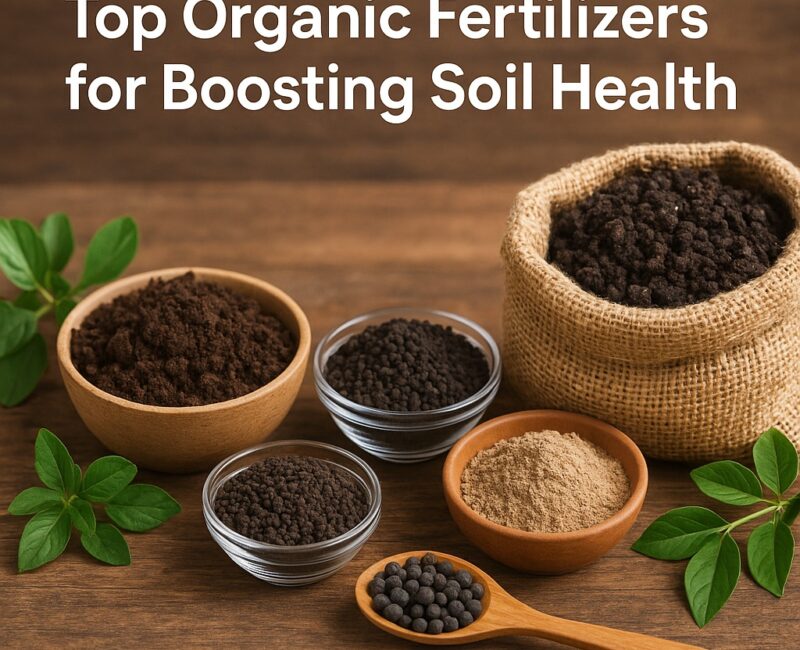The foundation of healthy crops starts with healthy soil. As regenerative and organic farming practices grow in popularity across the US, UK, Germany, and beyond, organic fertilizers are emerging as a top solution for restoring soil health without the harsh impact of synthetic chemicals.
In this blog, we’ll explore the top organic fertilizers in 2025, how they benefit soil, and which options are best for small-scale farmers, gardeners, and agri-entrepreneurs. 🌱✨
Why Choose Organic Fertilizers Over Synthetic Ones?
- Eco-friendly: No harmful runoff or long-term soil damage.
- Improves soil microbiome: Feeds beneficial bacteria and fungi.
- Long-term sustainability: Builds up the soil year after year.
- Safe for pollinators and kids: Great for homes and community gardens.
According to Rodale Institute, organically managed soils show 30% more biodiversity and better resilience during droughts.
Top Organic Fertilizers to Try in 2025
1. Vermicompost (Worm Castings)
- Why it rocks: Packed with microbes, enzymes, and natural growth hormones.
- Ideal for: Vegetable gardens, herbs, and leafy greens.
- Bonus: Odorless and can be DIY’d with a home worm bin.
2. Composted Cow Dung
- Why it rocks: High in nitrogen and carbon. Improves soil aeration.
- Ideal for: Fruit trees, grains, and flowers.
- Note: Needs to be well-rotted before use.
3. Bone Meal
- Why it rocks: Rich in phosphorus — promotes root development and flowering.
- Ideal for: Flowering plants, roses, bulbs.
- Tip: Use sparingly and mix into the soil.
4. Seaweed Extract / Kelp Meal
- Why it rocks: Contains trace elements and plant growth regulators.
- Ideal for: All crops, especially during transplant shock.
- Pro tip: Works wonders in foliar spray form.
5. Neem Cake Fertilizer
- Why it rocks: Organic pest control + soil conditioner.
- Ideal for: Vegetables and fruiting plants.
- Also acts as: Nematode and fungal repellent.
6. Green Manure (Cover Crops)
- Why it rocks: Natural nitrogen fixers like clover and alfalfa.
- Ideal for: Larger plots and seasonal rotation.
- Sustainable win: Reduces the need for additional inputs.
7. Fish Emulsion
- Why it rocks: High nitrogen boost for leafy plants.
- Ideal for: Greens like spinach, kale, and lettuce.
- Quick release: Great for fast-acting results.
How to Choose the Right Fertilizer for Your Soil
- Test your soil before adding anything — know what it’s missing.
- Choose balanced options if you’re unsure: like vermicompost or compost tea.
- Match your fertilizer to crop type — root crops need phosphorus, leafy greens love nitrogen.
- Consider release speed: fish emulsion is quick, whereas bone meal is slow.
Organic Fertilizer Application Tips
- Don’t overdo it — organic doesn’t mean “unlimited.”
- Apply during the early morning or evening to avoid nutrient evaporation.
- Water well after application to help nutrients reach the root zone.
- Rotate types across seasons to maintain balanced nutrient levels.
What Makes a Fertilizer Truly Organic?
- Certified by authorities like OMRI (US), Soil Association (UK), or FiBL (EU).
- No chemical additives, synthetic stabilizers, or genetically modified ingredients.
- Derived from natural sources — plants, animals, or minerals.
Fun fact: Organic fertilizer sales in North America hit $1.9 billion in 2024, and demand is rising in urban agriculture and container gardening.
Benefits of Organic Fertilizers for Small-Scale Farmers
- Lower long-term costs — especially when DIY’d.
- Eco branding — helps in marketing farm produce as clean, organic, or sustainable.
- Improves yield over time — thanks to enhanced soil structure and nutrient availability.
Final Thoughts 🌿
Switching to organic fertilizers is more than just a trend — it’s an investment in soil health, plant vitality, and long-term productivity. Whether you’re growing in a backyard or running a small farm, choosing the right organic input can help you farm better and greener in 2025.
Ready to grow naturally? Share this blog with your fellow green thumbs and drop your favorite fertilizer picks in the comments! 💚





